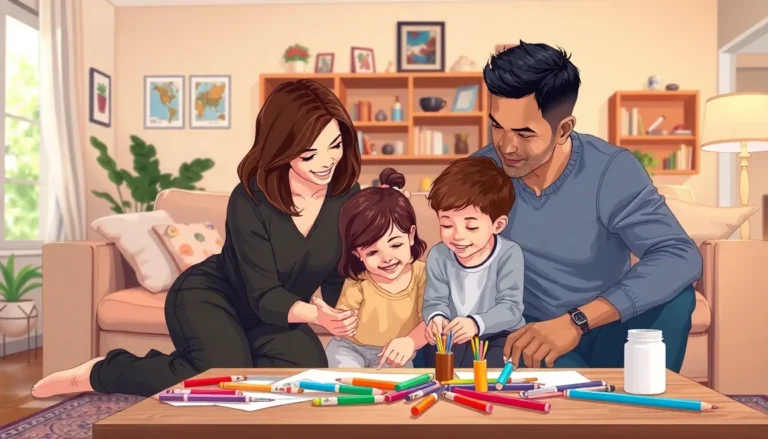Table of Contents
ToggleFamily estrangement is no longer an uncommon topic in today’s society. Once considered a taboo, the concept of cutting ties with family members has gained visibility and acceptance. As individuals seek healthier relationships and prioritize their mental well-being, many are choosing to distance themselves from toxic family dynamics.
This shift reflects broader cultural changes, where traditional family structures are evolving and personal autonomy takes precedence. The rise of social media and online communities has further amplified these conversations, allowing people to share their experiences and find support. Understanding how family estrangement became normalized reveals a complex interplay of societal expectations, mental health awareness, and personal empowerment.
Overview of Family Estrangement
Family estrangement refers to the emotional and physical distance between family members. This phenomenon has gained visibility in recent years, transitioning from a societal taboo to a recognized issue affecting many households. Studies indicate that approximately 27% of Americans report being estranged from a close family member. The acceptance of family estrangement often stems from escalating mental health awareness, leading individuals to prioritize their emotional well-being.
Factors influencing estrangement include toxic relationships, unresolved conflicts, and differing values. Individuals increasingly recognize that maintaining distance from harmful family dynamics can be a form of self-care. Sociocultural shifts emphasize individual autonomy, encouraging individuals to assess the benefits of familial connections against the emotional toll they can impose.
The impact of social media cannot be overlooked. Online platforms provide a space for people to discuss their experiences openly, find support, and share resources. Such discussions foster a sense of community among those dealing with similar situations, normalizing estrangement in everyday conversations.
Higher levels of mental health awareness also contribute to the normalization of estrangement. With a growing understanding of mental health issues, individuals find strength in choosing self-preservation over familial obligations. As a result, estrangement has emerged as an option for many seeking healthier relational dynamics.
Historical Context of Family Dynamics

Family dynamics have evolved significantly over the past century. Changes arise from shifts in societal values, cultural norms, and individual priorities. Understanding these transformations provides insight into the contemporary acceptance of family estrangement.
The Changing Nature of Family Structures
Family structures transitioned from extended kinship systems to nuclear families in the 20th century. Nuclear families, consisting of parents and children, became prevalent due to urbanization and economic shifts. Later, the diversity of family units expanded to include single-parent households, blended families, and same-sex couples. These variations illustrate a departure from traditional definitions of family, reflecting a growing recognition of personal choice and varying relationship forms. As family definitions broadened, so did the understanding of personal boundaries within these structures.
Key Factors Influencing Relationships
Several factors contribute to changing relationships among family members.
- Toxicity of Relationships: Individuals increasingly acknowledge the detrimental effects of toxic behaviors on mental health, leading many to distance themselves from negative influences.
- Conflict Resolution: Unresolved conflicts often breed estrangement, as family members struggle to address underlying issues.
- Value Differences: Discord arising from differing beliefs, lifestyles, and values can create rifts, prompting individuals to reassess their connections.
- Mental Health Awareness: Growing awareness and prioritization of mental health encourage individuals to leave harmful dynamics, viewing estrangement as a path to self-care.
- Cultural Attitudes: Societal shifts emphasize personal autonomy and self-fulfillment, fostering an environment where individuals prioritize their well-being over traditional family obligations.
These factors collectively impact relationships, prompting broader acceptance of familial distance as a legitimate choice for emotional health.
Psychological Factors Behind Estrangement
Family estrangement often stems from various psychological factors that influence individuals’ decisions to distance themselves from toxic dynamics. Understanding these factors sheds light on the normalization of estrangement in contemporary society.
Individual Mental Health and Family Relationships
Mental health plays a crucial role in family relationships. Individuals prioritize their emotional well-being when faced with damaging interactions or unresolved conflicts. Many people recognize that toxic family dynamics can exacerbate stress, anxiety, and depression. The decision to distance oneself becomes a form of self-preservation, highlighting an increase in mental health awareness. Support systems available through social media and therapy further encourage individuals to seek healthier connections and prioritize their mental health. The recognition of personal agency empowers individuals to make choices that reflect their needs, often leading to estrangement if family members resist understanding or change.
The Impact of Generational Differences
Generational differences significantly impact family relationships and contribute to estrangement. Older generations often adhere to traditional family structures and values, while younger generations prioritize personal fulfillment and mental health. These divergent perspectives may lead to tensions and misunderstandings. Younger individuals may feel constrained by family expectations, prompting them to pursue autonomy outside their familial ties. Research indicates that approximately 70% of millennials prioritize mental health over traditional familial duties, signaling a shift in values. As a result, estrangement occurs as individuals refuse to compromise their well-being for the sake of maintaining family ties. Understanding these generational dynamics clarifies the increasing acceptance of estrangement as a legitimate and often necessary decision.
Societal Influence on Family Estrangement
Societal factors significantly influence the acceptance of family estrangement in modern culture, shaping perspectives and behaviors around familial relationships.
Cultural Shifts and Acceptance
Cultural shifts have transformed the narrative surrounding family estrangement. Emphasis on individualism has led people to prioritize personal well-being over traditional familial obligations. Over the past few decades, society has shifted from collective familial expectations to a focus on personal autonomy, allowing individuals to choose emotional health over potentially harmful relationships. Studies indicate that over 60% of individuals consider mental health a top priority, contributing to the acceptance of distancing from toxic family members. This cultural evolution normalizes estrangement, making it a valid choice for many seeking healthier connections and personal fulfillment.
The Role of Social Media in Estrangement
Social media plays a pivotal role in normalizing family estrangement by providing platforms for discussion and support. Online communities foster connections among individuals who share similar experiences, reducing feelings of isolation. These platforms allow users to share personal stories, gain insight, and seek advice, reinforcing the idea that estrangement is a legitimate response to toxic dynamics. Research shows that nearly 50% of individuals discuss family estrangement online, highlighting the significance of digital dialogue in shaping perceptions. The visibility afforded by social media accelerates societal acceptance, creating an environment where estrangement becomes more understood and validated.
Personal Narratives and Case Studies
Real-life experiences illustrate the complexities of family estrangement. These narratives reveal the emotional weight of distancing from loved ones while highlighting the journey toward personal well-being.
Real-Life Stories of Estrangement
Families face estrangement for various reasons. Individuals share stories of navigating toxic environments, grappling with long-standing emotional pain, and making empowering decisions to protect their mental health.
- Adele’s Experience: Adele, 32, ended contact with her mother due to unresolved childhood trauma. She describes the relief that followed her decision, enabling her to focus on her own mental health and self-growth.
- Mark’s Journey: Mark, 45, sought distance from his father’s aggressive behavior. Over time, he learned to redefine what family means, prioritizing relationships that uplift him.
- Sarah’s Path: Sarah, 28, stopped communicating with her sister after years of competition and judgment. Embracing her individuality allowed her to cultivate supportive friendships and build a healthier personal life.
These narratives resonate with many, demonstrating that estrangement often becomes a source of liberation rather than loss.
Coping Mechanisms and Healing Journeys
Estrangement leads many to adopt coping strategies that foster healing and resilience. Various methods help individuals process emotions and rebuild their sense of self.
- Therapy: Engaging in individual or group therapy provides a supportive environment for discussing feelings of estrangement and promoting emotional recovery.
- Support Groups: Joining support groups allows individuals to connect with others who share similar experiences, fostering community and understanding.
- Mindfulness Practices: Practicing mindfulness techniques, such as meditation or journaling, helps individuals release negative feelings and cultivate self-compassion.
- Creative Outlets: Expressing emotions through art, writing, or music often serves as an effective tool for healing and self-discovery.
Through these mechanisms, individuals navigate the complexities of estrangement and find pathways toward emotional well-being.
The normalization of family estrangement represents a significant cultural shift. As individuals prioritize their mental health and emotional well-being, they increasingly recognize that distancing from toxic relationships can be a form of self-care. This evolving perspective reflects broader societal changes that value personal autonomy over traditional family obligations.
With the support of social media and increased mental health awareness, conversations around estrangement have gained visibility. This acceptance allows individuals to navigate their relationships on their own terms, fostering a deeper understanding of personal boundaries. Ultimately, family estrangement is no longer seen as a failure but rather as a courageous choice toward a healthier life.







